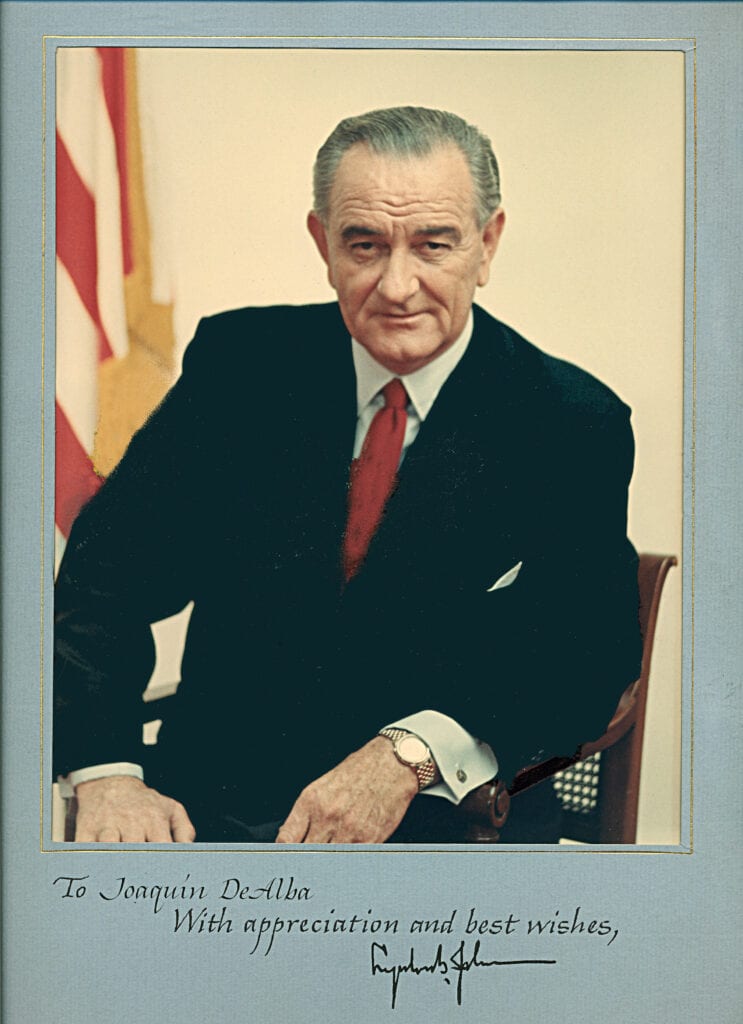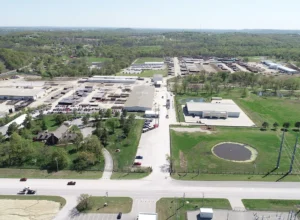Lyndon B. Johnson became the 36th president of the United States under dire circumstances. He was sworn into office aboard Air Force One, on November 22, 1963, at 2:38 p.m. CST, following the tragic death by assassination of John F. Kennedy.

Lyndon Baines Johnson was born on August 27, 1908, near Stonewall, Texas, northwest of San Antonio, in a small farmhouse on the Pedernales River. He was the oldest of five children born to Samuel Ealy Johnson Jr., a farmer, businessman, and state legislator, and Rebekah Baines. Johnson had one brother, Sam Houston Johnson, and three sisters, Rebekah, Josefa, and Lucia. The nearby small community of Johnson City, Texas, was named after James Polk Johnson, who was Samuel Johnson Jr.’s cousin.
Johnson was a gangly, gabby youth in school who was elected president of his 11th-grade class. He graduated from Johnson City High School in 1924.
At the age of 15, Johnson enrolled at Southwest Texas State Teachers College (now Texas State University) in the summer of 1924. Within a few weeks Johnson moved to Southern California, where he worked at his cousin’s law firm and in sundry odd jobs.
Johnson moved back to Texas and enrolled at SWTC in 1926. He worked his way through school, participated in debate and campus politics, and edited the school newspaper, “The College Star.” From 1928 to 1929, Johnson paused his studies for nine months to teach Mexican–American children at the segregated Welhausen School in Cotulla, Texas, 90 miles south of San Antonio. The money he earned as a teacher allowed him to finish college, graduating in 1930.
Seeing the effects poverty and discrimination had on his students made a lasting impression on Johnson. After signing the Higher Education Act of 1965, he remarked, “I shall never forget the faces of the boys and the girls in that little Welhausen Mexican School, and I remember even yet the pain of realizing and knowing then that college was closed to practically every one of those children because they were too poor. And I think it was then that I made up my mind that this nation could never rest while the door to knowledge remained closed to any American.”
On November 17, 1934, Lyndon Baines Johnson married Claudia Alta “Lady Bird” Taylor, from Texas. They had two daughters, Lynda and Luci. Lady Bird Johnson, who was a “soft-spoken but well-educated woman from an affluent family,” subsequently became a crucial component of Johnson’s political success.
LBJ continued to teach school and later worked as a congressional aide before winning a seat in the US House of Representatives in 1937. Johnson was elected to the United States Senate from Texas in 1948 after narrowly winning the Democratic Party’s nomination. He was appointed the Senate Majority Whip in 1951. He became the Senate Minority Leader in 1953 and the Senate Majority Leader in 1955.
Historians Robert Caro and Robert Dalleck consider Lyndon Johnson the “most effective Senate majority leader in history.” One LBJ biographer suggests he was “the greatest intelligence gatherer Washington has ever known,” discovering exactly where every Senator stood on issues, his philosophy and prejudices, his strengths and weaknesses, and what it took to get his vote. “The treatment,” which was essential to LBJ’s political power, was described by journalists Rowland Evans and Robert Novak, who said it was, “supplication, accusation, cajolery, exuberance, scorn, tears, complaint, the hint of threat. It was all these together. It ran the gamut of human emotions. Its velocity was breathtaking, and it was all in one direction. Interjections from the target were rare. Johnson anticipated them before they could be spoken. He moved in close, his face a scant millimeter from his target, his eyes widening and narrowing, his eyebrows rising and falling. From his pockets poured clippings, memos, statistics. Mimicry, humor, and the genius of analogy made The Treatment an almost hypnotic experience and rendered the target stunned and helpless…”
After failing to secure the party nomination, Johnson was asked by John F . Kennedy to be his vice-presidential running mate. Kennedy needed the support of conservative Southern Democrats and Johnson’s presence on the ticket proved to play a central role in JFK’s narrow margin of victory in 1960.
Johnson was concerned about the lack of influence he was losing as VP as opposed to being the senate majority leader, and asked Kennendy to grant him power that was traditionally granted to the Vice President. It was a tumultuous tenure for LBJ because many members of the Kennedy White House held contempt for him, including the president’s brother, Attorney General Robert F. Kennedy. They ridiculed his perceived boorish manner. Congressman Tip O’Neill said that the Kennedys “had a disdain for Johnson that they didn’t even try to hide…They actually took pride in snubbing him.”
However, JFK kept Johnson busy, informed, and at the White House often, telling aides, “I can’t afford to have my vice president, who knows every reporter in Washington, going around saying we’re all screwed up, so we’re going to keep him happy.” Kennedy appointed Johnson to various committees, sent him on diplomatic missions, had him attend Cabinet and Security Council briefings, and appointed him Chairman of the National Aeronautics and Space Council.
Johnson was accused of seeking power hastily when he requested to be sworn in immediately following Kennedy’s death, but Johnson merely thought a grieving nation “in shock” needed stability. He and the Secret Service thought that he might be the target of a conspiracy and put him on a plane and rushed him to the White House.
Lyndon B. Johnson made an address to Congress in the days after the assassination, proclaiming that “No memorial oration or eulogy could more eloquently honor President Kennedy’s memory than the earliest possible passage of the Civil Rights Bill for which he fought so long.”
On November 29, 1963, Johnson issued an executive order to rename Cape Canaveral launch facilities as the John F. Kennedy Space Center. Cape Canaveral was officially known as Cape Kennedy from 1963 until 1973.
Shortly after taking office, Johnson began the task of creating what he called “The Great Society,” which was an ambitious agenda of progressive reforms aimed at eliminating poverty and racial injustice. It is considered one of the largest and most aggressive social reform plans in modern history.
This colossal effort resulted in the creation of Medicare, Medicaid, The Community Action Program, the Job Core, VISTA, which is the domestic counterpart to the Peace Corps, The Model Cities Program, the Higher Education Act of 1965, the Civil Rights Act of 1964, and the Voting Rights Act of 1965.
Although LBJ accomplished more progressive goals than any president since FDR, his legacy is blemished by the Vietnam war.
Johnson erroneously believed in the “Domino Theory,” that if Vietnam fell to the Communists, all of Asia would fall like dominoes in a row. He increased the number of troops from 16,000 to 500,000 during his time in office.
American and Vietnamese casualties mounted and anti-war protests rocked college campuses and cities across the U.S. Johnson’s approval rating plummeted precipitously, even among Democratic voters. In 1968 he decided not to seek another term.
In a nationally televised speech on March 31, 1968 Johnson told the nation, “I shall not seek, nor will I accept, the nomination of my party for another term as your president.”
Johnson retired to his ranch in Johnson City Texas, where he spent the next few years writing his memoirs and constructing his presidential library on the campus of the University of Texas at Austin, which opened in 1971. Johnson died of a heart attack on January 22, 1973, at the age of 64, at his ranch.
I strongly recommend two movies that depict the life and career of LBJ: “LBJ” and “All The Way.”










